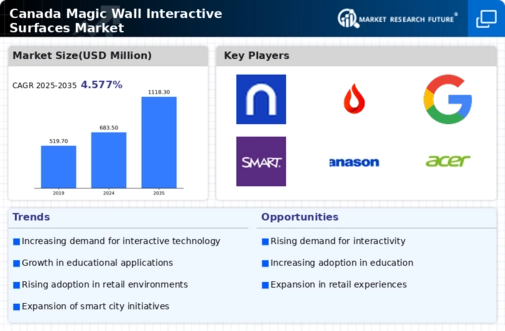The magic wall-interactive-surfaces market in Canada is characterized by a dynamic competitive landscape, driven by rapid technological advancements and increasing demand for interactive solutions across various sectors. Key players such as Microsoft (US), Samsung (KR), and LG Electronics (KR) are at the forefront, each adopting distinct strategies to enhance their market presence. Microsoft (US) focuses on innovation through its Azure cloud services, integrating AI capabilities into its interactive surfaces, thereby enhancing user engagement and operational efficiency. Meanwhile, Samsung (KR) emphasizes regional expansion, having recently launched a new line of interactive displays tailored for educational institutions, which reflects a strategic pivot towards the growing edtech sector. LG Electronics (KR) is also notable for its commitment to sustainability, investing in eco-friendly materials for its products, which aligns with the increasing consumer preference for environmentally responsible technology.
The business tactics employed by these companies include localizing manufacturing to reduce costs and optimize supply chains, which is particularly relevant in the current economic climate. The market structure appears moderately fragmented, with several players vying for market share, yet the collective influence of these key players shapes a competitive environment that is both challenging and opportunistic. The interplay between established brands and emerging startups fosters innovation, pushing the boundaries of what interactive surfaces can achieve.
In September 2025, Microsoft (US) announced a strategic partnership with a leading Canadian educational institution to develop customized interactive learning environments. This collaboration is significant as it not only enhances Microsoft's foothold in the education sector but also showcases its commitment to leveraging technology for improved learning outcomes. Such partnerships are likely to set a precedent for future collaborations, emphasizing the importance of tailored solutions in the market.
In October 2025, Samsung (KR) unveiled its latest interactive display technology at a major tech conference, highlighting features that integrate augmented reality (AR) capabilities. This move is crucial as it positions Samsung as a leader in the integration of AR into interactive surfaces, potentially attracting a diverse clientele from retail to corporate sectors. The emphasis on cutting-edge technology may provide Samsung with a competitive edge, particularly in environments where immersive experiences are paramount.
In August 2025, LG Electronics (KR) launched a new initiative aimed at recycling old interactive surfaces, thereby reinforcing its sustainability strategy. This initiative not only addresses environmental concerns but also enhances LG's brand image as a responsible corporate entity. The strategic importance of this move lies in its potential to attract environmentally conscious consumers, thereby expanding LG's market reach and fostering customer loyalty.
As of November 2025, the competitive trends in the magic wall-interactive-surfaces market are increasingly defined by digitalization, sustainability, and the integration of AI technologies. Strategic alliances are becoming more prevalent, as companies recognize the value of collaboration in driving innovation. Looking ahead, competitive differentiation is likely to evolve from traditional price-based competition to a focus on technological innovation, reliability in supply chains, and the ability to deliver customized solutions. This shift underscores the necessity for companies to adapt and innovate continuously to maintain relevance in a rapidly changing market.
























Leave a Comment